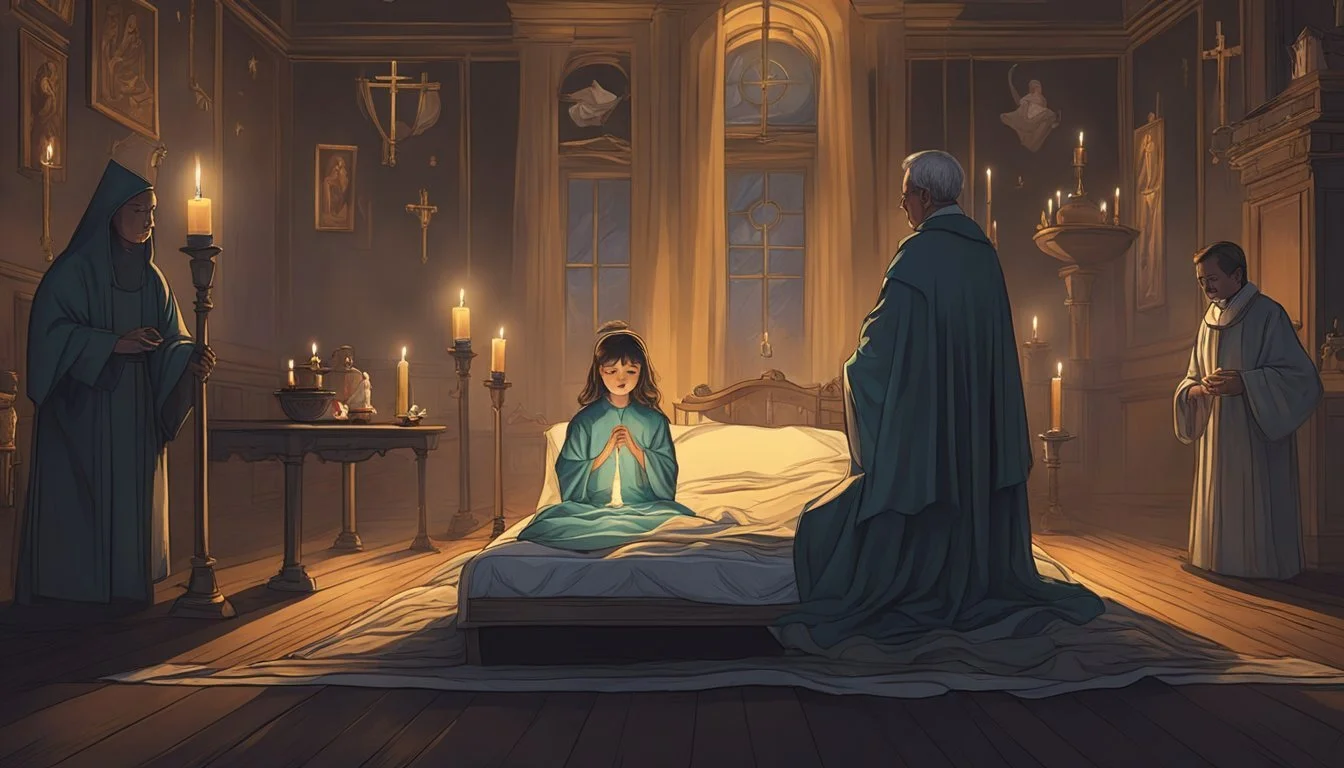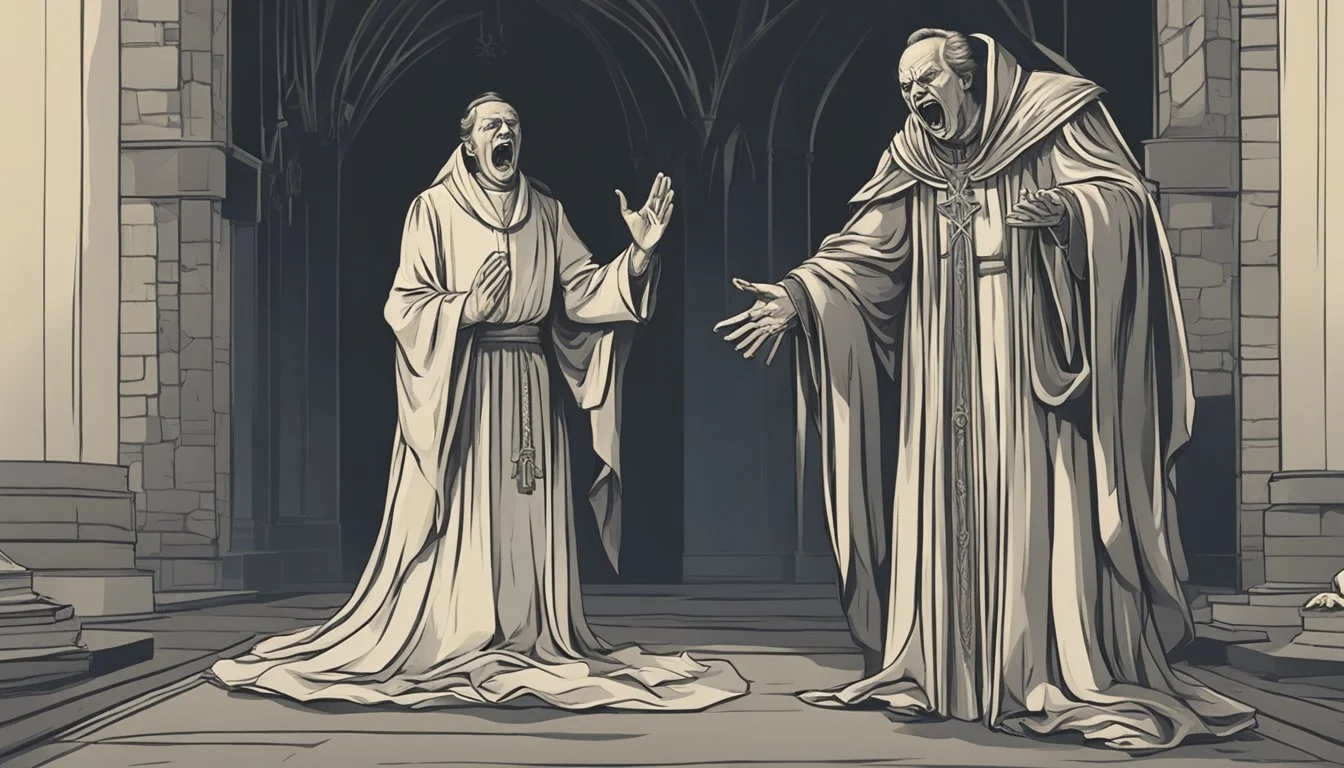The Actual Exorcism: The Chilling Reality of The Exorcist
Separating Fact from Fiction
The chilling tale behind "The Exorcist" has captivated audiences for decades. While the 1973 film shocked viewers with its disturbing portrayal of demonic possession, few realize it was inspired by actual events. In 1949, a 14-year-old boy known as "Roland Doe" underwent a series of exorcisms that would later form the basis for William Peter Blatty's novel and screenplay.
The real-life exorcism of Roland Doe involved strange occurrences, including furniture moving on its own and unexplained scratches appearing on the boy's body. These incidents began after the death of Roland's aunt, who had introduced him to Ouija boards. As the strange phenomena escalated, his desperate parents sought help from Catholic priests, leading to multiple exorcism attempts.
The case of Roland Doe sparked widespread interest and debate about the nature of possession and exorcism. While some viewed it as clear evidence of demonic forces, others sought scientific explanations for the reported events. Regardless of one's beliefs, the story continues to intrigue and unsettle, serving as a haunting reminder of the thin line between the natural and supernatural worlds.
Origins and Background
The roots of "The Exorcist" lie in a blend of real-life events and literary creation. This iconic horror story emerged from actual exorcism cases and the imagination of author William Peter Blatty, sparking widespread cultural fascination with demonic possession.
The Exorcist Novel by William Peter Blatty
William Peter Blatty published "The Exorcist" in 1971. The novel quickly became a bestseller, captivating readers with its chilling tale of demonic possession. Blatty's work drew inspiration from a 1949 exorcism case he learned about while studying at Georgetown University.
The book tells the story of Regan MacNeil, a young girl possessed by a demon, and the efforts to save her through exorcism. Blatty's vivid descriptions and psychological depth set a new standard for horror literature.
Real Exorcism Cases and Inspirations
The 1949 case that inspired Blatty involved a boy known pseudonymously as "Roland Doe" or "Robbie Mannheim." This 13-year-old from suburban Washington, D.C. reportedly exhibited strange behaviors after his aunt's death.
Priests performed multiple exorcisms on the boy, documenting supernatural occurrences like levitation and speaking in unknown languages. While skeptics question these claims, the case remains a significant influence on exorcism narratives.
Other real-life exorcisms have contributed to the genre's development, blending fact and fiction in popular imagination.
Cultural Impact of Exorcism Narratives
"The Exorcist" novel and its 1973 film adaptation profoundly impacted popular culture. The story sparked renewed interest in exorcism and demonic possession across various media.
Subsequent books, films, and TV shows explored similar themes, often claiming to be based on true events. This trend has led to increased public fascination with the supernatural and debates about the reality of demonic possession.
The narrative's influence extends beyond entertainment, affecting religious practices and beliefs about spiritual warfare in some communities. It has also prompted discussions about mental health and the interpretation of unexplained phenomena.
The Film Adaptation
William Friedkin directed the 1973 film adaptation of William Peter Blatty's novel "The Exorcist." The movie shocked audiences with its graphic depiction of demonic possession and became a cultural phenomenon.
Development and Production Challenges
Casting proved difficult for the pivotal role of Regan MacNeil. Several young actresses were considered before Linda Blair was chosen. The film's special effects team faced unique challenges in bringing the possession scenes to life. They used innovative techniques like refrigerated sets and a rotating bedroom to create realistic supernatural elements.
Friedkin's demanding directorial style led to tensions on set. He reportedly fired blanks to startle actors and slapped a priest to elicit an authentic reaction. These controversial methods contributed to the film's intense atmosphere but caused stress for the cast and crew.
Critical Reception and Box Office Success
"The Exorcist" opened to mixed reviews but quickly became a box office sensation. Many critics praised its groundbreaking special effects and performances. Some religious groups condemned the film for its graphic content and perceived blasphemy.
The movie earned $193 million domestically and became the highest-grossing R-rated horror film for decades. It received 10 Academy Award nominations, winning for Best Adapted Screenplay and Best Sound. "The Exorcist" sparked a cultural conversation about faith, evil, and the power of cinema to shock and provoke.
Its success led to multiple sequels and a lasting impact on the horror genre. The film continues to be studied and debated by critics and fans alike.
Description of Exorcism Rites
Exorcism rites follow specific protocols established by religious authorities. These rituals aim to expel evil spirits from afflicted individuals through prayers and sacred actions.
The Roman Ritual and Its Use in the Film
The Roman Ritual, a liturgical book used in Catholic exorcisms, forms the basis for many depictions in "The Exorcist". It contains specific prayers and actions for confronting demonic possession. The film incorporates elements of this ritual, such as the use of holy water and recitation of Latin prayers.
Exorcists in the movie employ crucifixes and invoke the power of Christ, mirroring actual practices. The dramatic physical manifestations shown, while exaggerated, draw inspiration from reported cases of possession.
Differentiation Between Hollywood and Reality
Hollywood depictions often amplify the sensational aspects of exorcisms for dramatic effect. Real exorcisms typically involve less overt supernatural phenomena than portrayed in films.
Actual exorcisms require extensive preparation, including medical and psychological evaluations. The process can be lengthy, sometimes spanning months or years. Church-sanctioned exorcists undergo rigorous training and operate under strict guidelines.
Unlike movie portrayals, genuine exorcisms prioritize prayer and spiritual counseling over theatrical confrontations. The focus remains on the afflicted person's well-being and spiritual healing rather than battling visible demonic forces.
Theological Perspectives
Exorcism holds significant theological importance across multiple faiths. Religious doctrines provide frameworks for understanding and addressing demonic possession, though perspectives vary between traditions.
Catholic Doctrine on Exorcism
The Catholic Church maintains strict protocols for exorcism. Only trained priests with episcopal authorization can perform the rite. The Church emphasizes discernment, requiring thorough medical and psychological evaluations before considering exorcism.
Catholic doctrine views possession as rare but real. The Catechism states demons can exercise power over individuals, objects, and places. Exorcism is seen as a form of healing ministry, invoking God's power to liberate the afflicted.
The rite involves specific prayers, holy water, and sacred objects. Priests warn against sensationalism, stressing exorcism's spiritual nature rather than dramatic manifestations often portrayed in media.
Comparative Religious Views
Many religions recognize concepts of spiritual oppression or possession. Protestant denominations vary in their approaches, with some performing "deliverance ministry" rather than formal exorcisms.
Islam acknowledges jinn possession and prescribes Quranic recitation as treatment. Hindu traditions include exorcism rituals to expel malevolent spirits. Buddhism offers meditation and chanting practices to address spiritual disturbances.
Jewish tradition rarely mentions demonic possession but includes prayers for protection against evil influences. Some indigenous religions incorporate shamanic practices to heal spiritual afflictions.
While methods differ, most faiths emphasize the power of prayer, faith, and divine intervention in confronting perceived demonic forces.
Psychological and Societal Aspects
"The Exorcist" sparked intense debate about mental health, religious practices, and media influence. Its impact reached far beyond entertainment, shaping public perceptions and professional approaches to unusual behaviors.
Mental Health and Misdiagnoses
Psychiatrists raised concerns about potential misdiagnoses following the film's release. Some patients exhibited symptoms mimicking possession, leading to a phenomenon dubbed "cinematic neurosis."
Mental health professionals emphasized the importance of thorough psychological evaluations before considering supernatural explanations. They highlighted conditions like dissociative identity disorder, schizophrenia, and epilepsy as possible causes for seemingly demonic behaviors.
The movie prompted discussions about the intersection of faith and mental health treatment. Some religious leaders advocated for collaboration between clergy and mental health professionals in addressing complex cases.
Media Influence and Public Perception
"The Exorcist" significantly altered public perception of exorcisms and demonic possession. Its vivid portrayal left a lasting impression on viewers, sometimes blurring the line between fiction and reality.
The film revived interest in exorcism rituals across various religious denominations. Reports of exorcism requests increased in the years following its release.
Media coverage of real-life exorcisms often drew comparisons to the movie, potentially sensationalizing actual events. This led to debates about responsible reporting on religious practices and mental health issues.
The movie's impact extended to academic circles, inspiring sociological studies on the relationship between popular culture and religious beliefs. Researchers examined how media representations influence public understanding of complex spiritual and psychological phenomena.
Technical Achievements
"The Exorcist" set new standards for horror filmmaking through groundbreaking special effects and innovative sound design. These technical elements elevated the film's realism and intensified its impact on audiences.
Special Effects Breakthroughs
The film's visual effects team created several iconic moments that pushed the boundaries of practical effects. The infamous 360-degree head turn was achieved using a lifelike dummy with a mechanized neck.
For the levitation scenes, the crew built a tilting set and used hidden harnesses to lift actress Linda Blair. The "projectile vomiting" effect utilized a hidden tube to spray pea soup mixed with oatmeal.
Makeup artist Dick Smith crafted detailed prosthetics to transform Blair's appearance, including foam latex applications for her disfigured face. These techniques helped create a viscerally disturbing portrayal of demonic possession.
Sound Design and Score Contribution
"The Exorcist" utilized innovative sound design to create an unsettling atmosphere. The film's sound team recorded animal noises and distorted them to create the demon's voice.
They also incorporated subliminal sounds, like buzzing bees and pig squeals, to induce anxiety in viewers. The creaking of the house and whispering voices added to the eerie ambiance.
Composer Mike Oldfield's "Tubular Bells" became an iconic theme, its haunting melody enhancing the film's sense of dread. The score's minimalist approach allowed the sound effects to take center stage during key scenes.
The film's use of silence was equally impactful, creating tension through contrast with the more intense auditory moments.
Legacy and Continued Relevance
"The Exorcist" left an indelible mark on horror cinema and popular culture. Its influence sparked numerous spin-offs and adaptations across various media. The film also reignited interest in exorcism practices, shaping perceptions of demonic possession for decades.
Sequels, Prequels, and Spin-Offs
"The Exorcist" franchise expanded significantly since the original 1973 film. Two direct sequels followed: "Exorcist II: The Heretic" (1977) and "The Exorcist III" (1990). Prequels joined the series with "Exorcist: The Beginning" (2004) and "Dominion: Prequel to the Exorcist" (2005).
A television series aired from 2016 to 2017, continuing the story in a modern setting. In 2023, "The Exorcist: Believer" marked a new chapter, with Ellen Burstyn reprising her role as Chris MacNeil.
These spin-offs varied in critical reception but maintained audience interest in the franchise's themes and mythology.
Modern Exorcism Practices and Pop Culture
"The Exorcist" profoundly impacted public perception of exorcisms and demonic possession. The film sparked renewed interest in these practices within religious communities.
Exorcism-themed entertainment proliferated across media:
Movies: "The Conjuring" series, "The Rite"
TV shows: "Supernatural", "Evil"
Books: Non-fiction accounts of exorcisms
This trend reflects ongoing fascination with the supernatural and the eternal struggle between good and evil. While skepticism about real-life exorcisms persists, the concept remains a potent source of fear and intrigue in popular culture.






